Bird Survival Tactics in Winter

Photo by Steve Roark
By: Steve Roark
Volunteer, Cumberland Gap National Historical Park
Many birds remain in our area during the winter and don’t fly off to warmer climes. Songbirds (also called passerines) have a normal body temperature of 105 degrees Fahrenheit and yet appear to go about their business on cold days in comfort. They have several adaptations and tactics to make it through the winter, mostly involving maximizing calories consumed while minimizing calories spent.
A thick covering of body feathers provides birds with effective insulation. They will fluff them up on cold days to trap warm air near their body. A chickadee has approximately 2000 body feathers and has muscular control over all of them. Raising feathers to trap heat and lowering feathers to cool down allows birds to adjust to varying temperatures. They also remain relatively dry when it rains or snows because they coat their body and flight feathers with oil secreted by a gland at the upper base of the tail. The oil is water repellent and permits the bird to remain relatively dry even during a rainstorm.
Sending warm blood to extremities such as feet to keep them warm cools down the core body temperature when it returns through veins to be rewarmed. To minimize this loss, many birds have feet that are kept at close to freezing during the winter. Their comfort level with cold feet is apparently way lower than mine….brrr!
To stay warm while roosting, birds will seek shelter to protect them from wind, rain, and cold nighttime temperatures. Tree cavities are used by several species. The brown creeper, nuthatch, wren, and bluebird will often roost in groups to share body heat. Finches, sparrows, crows, blue jays, and doves roost in dense clumps of cedars or pine. The thick cover of evergreen branches helps reduce wind chill and provides a warmer surrounding. Evergreen thermal shelters are a great addition for those wanting to make their yards or farms more wildlife friendly.
Birds spend more time foraging during the winter than they do in summer to keep the body heat engine stoked to remain warm. When temperatures are extremely cold, birds may opt to remain inactive because the energy lost in foraging is not worth it.
Having bird feeders is an enjoyable way to help birds during the winter. Provide high energy feeds such as suet and sunflower seeds. Once you start feeding birds, don’t stop until warmer weather. The sudden end of a food source is stressful.
- Log in to post comments